Abstract
OBJECTIVES: A population based case-control study was conducted in a highly agricultural area in Italy to investigate the association between chronic lymphocytic leukaemias (CLLs) and non-Hodgkin's lymphomas (NHLs), and subtypes, and exposure to pesticides in farming-animal breeding workers. METHODS: 187 cases of CLLs and NHLs and 977 population controls were interviewed on medical, residential, family, and occupational history. Detailed information was collected about cultivated crops and animals bred from subjects who worked in farming and animal breeding. Information on crop diseases and pesticides used (and their quantity and duration) was also obtained. A priori job-exposure matrices were applied when a crop disease was reported, estimating the most probable pesticide and, when possible, an estimate of the cumulative dose. Odds ratios (ORs) were calculated by unconditional logistic analysis with adjustment for relevant confounders in farmers who bred animals and in farmers alone, for the main crops, types of animals, and pesticides categories. First recall and then the matrices were used for defining exposure, as it affected CLLs and NHLs and then separately on CLLs and low grade NHLs. Finally, the dose-response was investigated for those pesticides which had shown some association. RESULTS: No variable under study was associated with work in farming alone. In farming and animal breeding, no crop or animal showed an association with CLLs and NHLs when adjusted by exposure during childhood to farming and animal breeding (an indicator of life in a farming and animal breeding environment before the age of 13, which behaved as an independent risk variable). A non-significant association was found with stannates, arsenates, phosphates, and dichloro-diphenyl-trichloroethane (DDT) based on recall, and for stannates, arsenates, and DDT after the application of the matrices. When CLLs together with low grade NHLs were considered, the association with insecticides in general, carbamates, and phosphates became significant according to personal recall (ORs and 95% confidence intervals (95% CIs) 2.46, 1.07-5.63; 3.08, 1.05-9.00; 2.97, 1.28-6.91, respectively). The application of the matrices also showed a risk of borderline significance for stannates and dithiocarbamates. A significant dose-response effect was found for phosphates (for logarithmic unit increase, OR 1.17, 95% CI 1.00-1.57); a strong trend for stannates and carbamates did not reach significance. CONCLUSION: The association of CLLs and NHLs with work in farming-animal breeding is partially explained by exposure to pesticides-namely insecticides (carbamates, phosphates, and DDT) and stannates-possibly related to their use in animal breeding. The association is limited to cases of CLL and low grade NHL. The independent effect of the variable exposure during childhood suggests that early exposures, including possible contact with animals, may play a part in the pathogenic process of these neoplasms.
Full text
PDF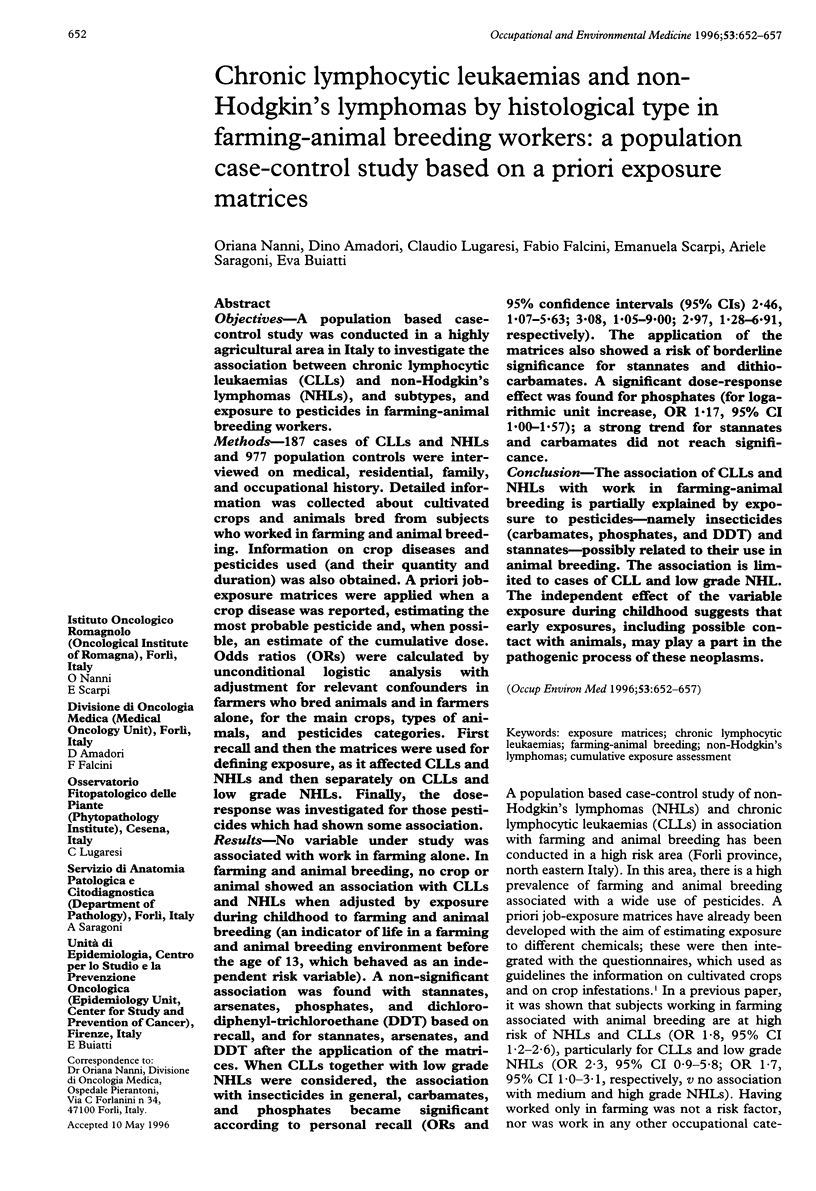
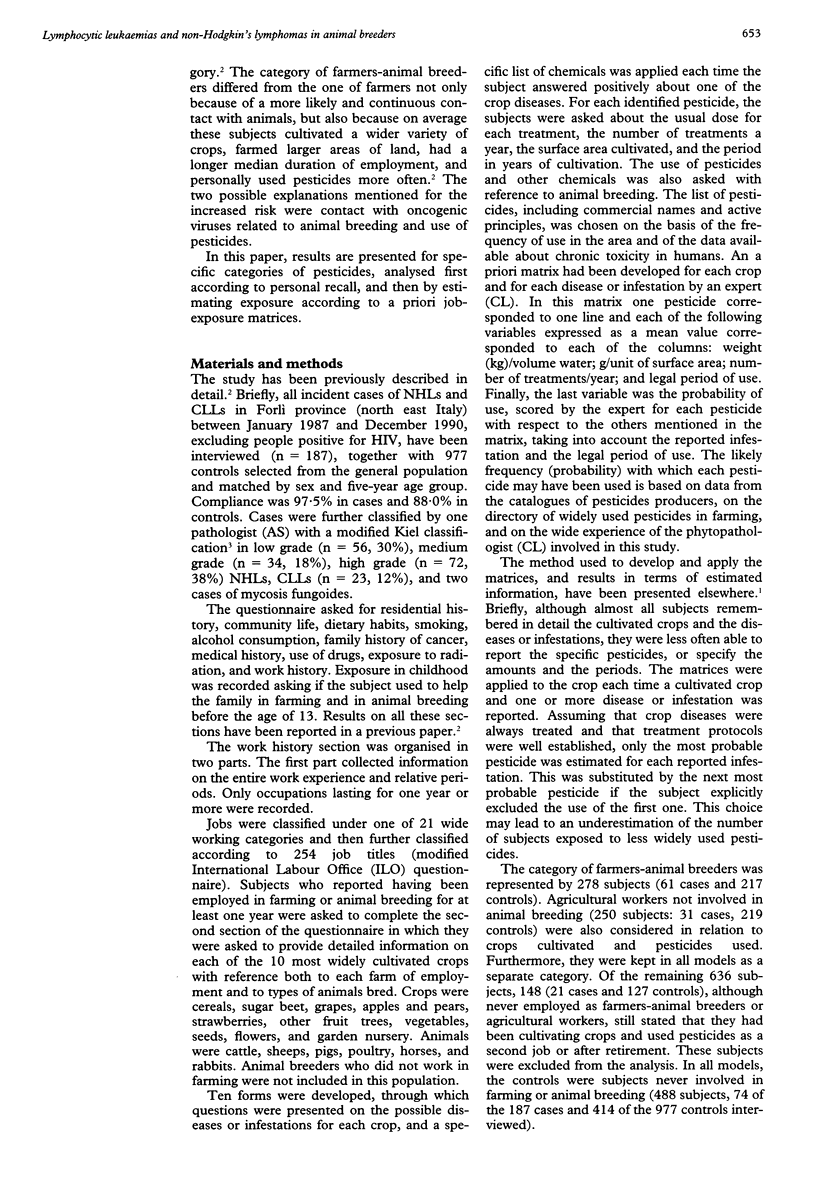
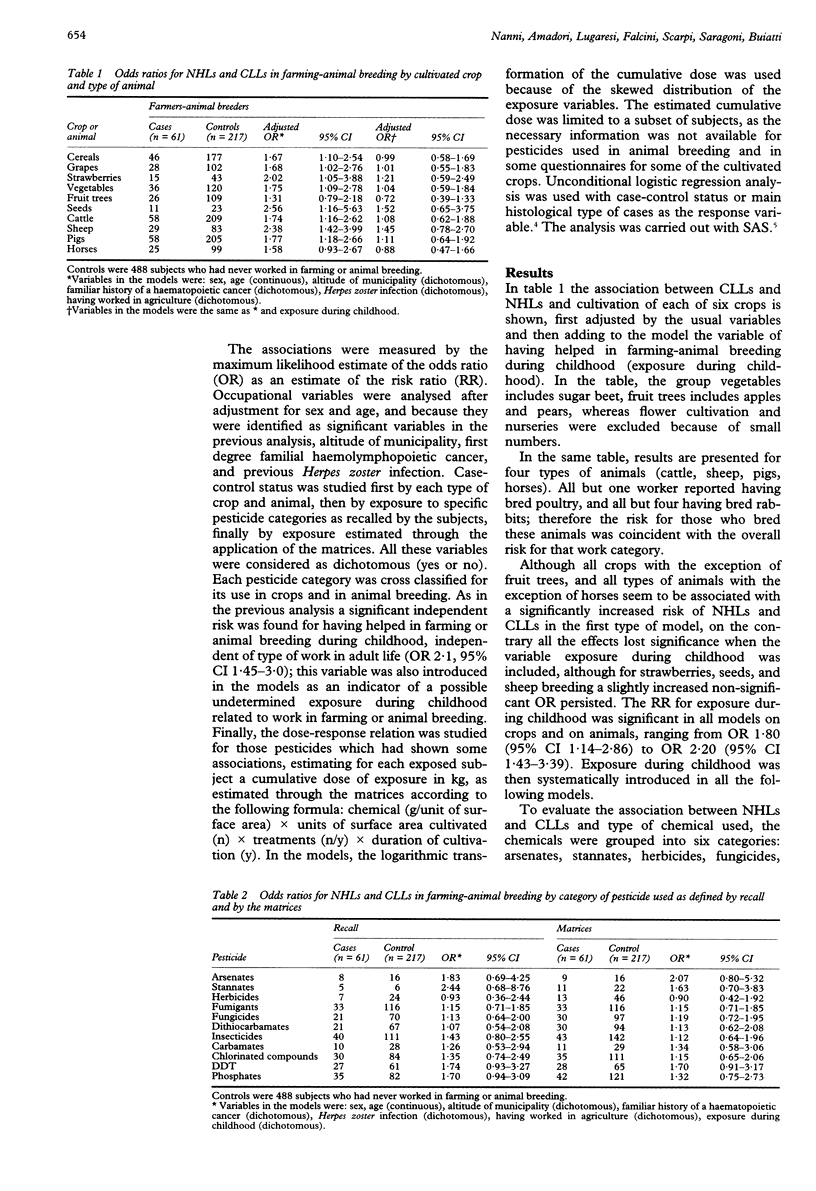
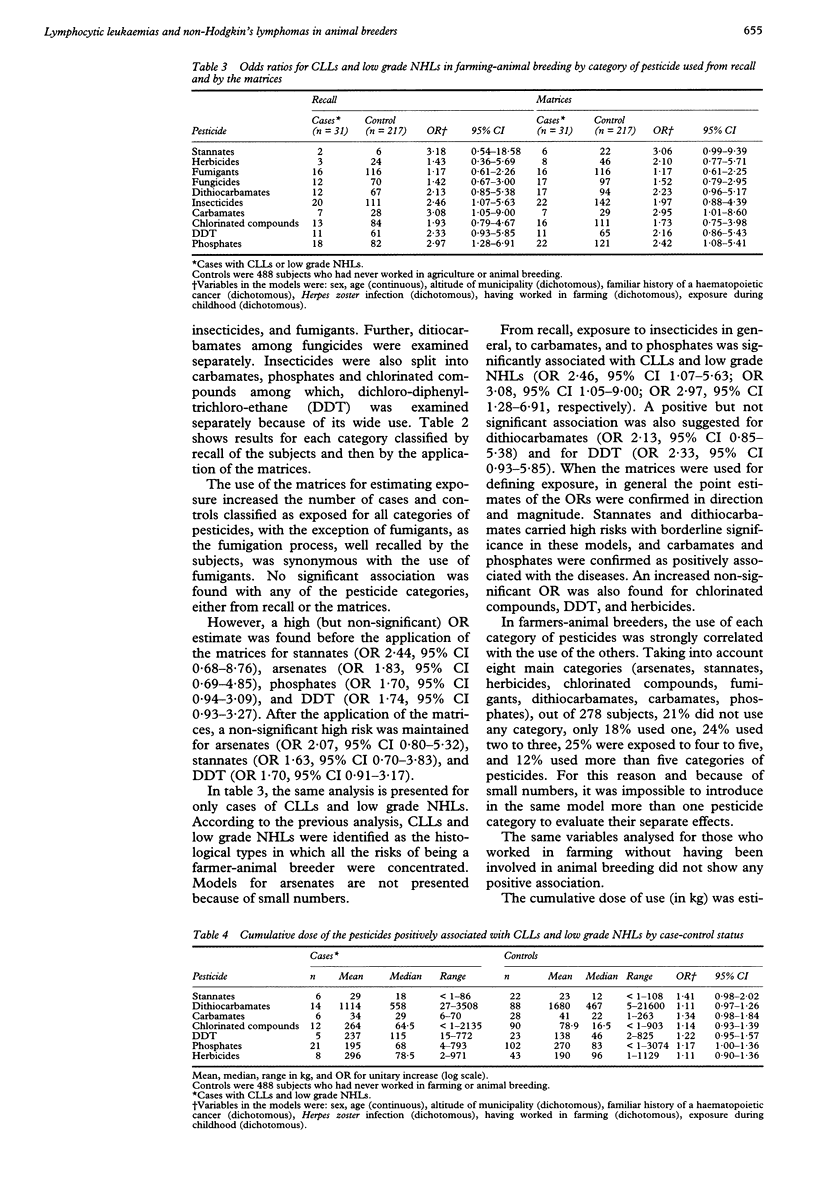

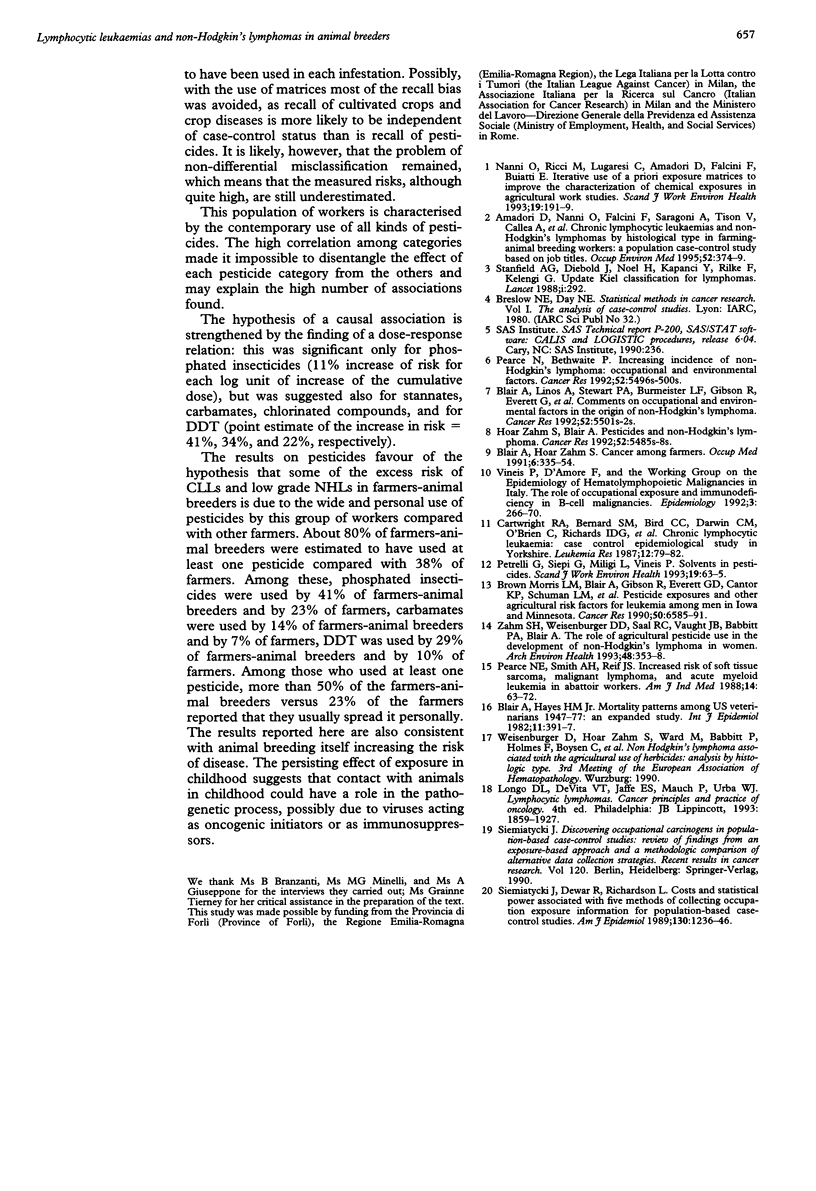
Selected References
These references are in PubMed. This may not be the complete list of references from this article.
- Amadori D., Nanni O., Falcini F., Saragoni A., Tison V., Callea A., Scarpi E., Ricci M., Riva N., Buiatti E. Chronic lymphocytic leukaemias and non-Hodgkin's lymphomas by histological type in farming-animal breeding workers: a population case-control study based on job titles. Occup Environ Med. 1995 Jun;52(6):374–379. doi: 10.1136/oem.52.6.374. [DOI] [PMC free article] [PubMed] [Google Scholar]
- Blair A., Hayes H. M., Jr Mortality patterns among US veterinarians, 1947-1977: an expanded study. Int J Epidemiol. 1982 Dec;11(4):391–397. doi: 10.1093/ije/11.4.391. [DOI] [PubMed] [Google Scholar]
- Blair A., Zahm S. H. Cancer among farmers. Occup Med. 1991 Jul-Sep;6(3):335–354. [PubMed] [Google Scholar]
- Brown L. M., Blair A., Gibson R., Everett G. D., Cantor K. P., Schuman L. M., Burmeister L. F., Van Lier S. F., Dick F. Pesticide exposures and other agricultural risk factors for leukemia among men in Iowa and Minnesota. Cancer Res. 1990 Oct 15;50(20):6585–6591. [PubMed] [Google Scholar]
- Cartwright R. A., Bernard S. M., Bird C. C., Darwin C. M., O'Brien C., Richards I. D., Roberts B., McKinney P. A. Chronic lymphocytic leukaemia: case control epidemiological study in Yorkshire. Br J Cancer. 1987 Jul;56(1):79–82. doi: 10.1038/bjc.1987.158. [DOI] [PMC free article] [PubMed] [Google Scholar]
- Nanni O., Ricci M., Lugaresi C., Amadori D., Falcini F., Buiatti E. Iterative use of a priori exposure matrices to improve the characterization of chemical exposures in agricultural work studies. Scand J Work Environ Health. 1993 Jun;19(3):191–199. doi: 10.5271/sjweh.1482. [DOI] [PubMed] [Google Scholar]
- Pearce N., Smith A. H., Reif J. S. Increased risks of soft tissue sarcoma, malignant lymphoma, and acute myeloid leukemia in abattoir workers. Am J Ind Med. 1988;14(1):63–72. doi: 10.1002/ajim.4700140108. [DOI] [PubMed] [Google Scholar]
- Petrelli G., Siepi G., Miligi L., Vineis P. Solvents in pesticides. Scand J Work Environ Health. 1993 Feb;19(1):63–65. doi: 10.5271/sjweh.1502. [DOI] [PubMed] [Google Scholar]
- Siemiatycki J., Dewar R., Richardson L. Costs and statistical power associated with five methods of collecting occupation exposure information for population-based case-control studies. Am J Epidemiol. 1989 Dec;130(6):1236–1246. doi: 10.1093/oxfordjournals.aje.a115452. [DOI] [PubMed] [Google Scholar]
- Stansfeld A. G., Diebold J., Noel H., Kapanci Y., Rilke F., Kelényi G., Sundstrom C., Lennert K., van Unnik J. A., Mioduszewska O. Updated Kiel classification for lymphomas. Lancet. 1988 Feb 6;1(8580):292–293. doi: 10.1016/s0140-6736(88)90367-4. [DOI] [PubMed] [Google Scholar]
- Vineis P., D'Amore F. The role of occupational exposure and immunodeficiency in B-cell malignancies. Working Group on the Epidemiology of Hematolymphopoietic Malignancies in Italy. Epidemiology. 1992 May;3(3):266–270. doi: 10.1097/00001648-199205000-00014. [DOI] [PubMed] [Google Scholar]
- Zahm S. H., Weisenburger D. D., Saal R. C., Vaught J. B., Babbitt P. A., Blair A. The role of agricultural pesticide use in the development of non-Hodgkin's lymphoma in women. Arch Environ Health. 1993 Sep-Oct;48(5):353–358. doi: 10.1080/00039896.1993.9936725. [DOI] [PubMed] [Google Scholar]


